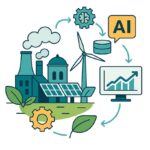Introduction
The Fourth Industrial Revolution, also known as Industry 4.0, is a disruptive idea that transforming the way industries work by harnessing cutting-edge technology to boost productivity, efficiency, and competitiveness. This article delves into the core ideas of Industry 4.0. It presents real-world examples of its use in a variety of industries.
Recognizing Industry 4.0
Manufacturing and industry are experiencing a paradigm change due to Industry 4.0. It distinguishes itself by using digital technology, data analytics, and the Internet of Things (IoT) in manufacturing. This digital revolution helps businesses build smart factories and supply networks, promoting a more flexible, efficient, and customer-centric manufacturing strategy.
The Fundamental Principles of Industry 4.0
1. Interconnectivity: The Internet of Things (IoT) connects machines and systems in Industry 4.0. Sensors and gadgets connect, exchanging real-time data and allowing for intelligent decision-making. This link enhances transparency and cooperation within the operations of a corporation.
2. Data Analytics: Data analytics exploits the massive volume of data created by networked devices. Thanks to advanced algorithms and machine learning, companies may get useful insights, streamline operations, and estimate maintenance needs.
3. Robotics and Automation: Automation and robots are important components of Industry 4.0. Smart machines can do jobs with greater accuracy and speed, decreasing human error and enhancing production efficiency. The usage of robotic arms in automobile assembly lines is one example of this.
4. Augmented and virtual reality (AR/VR): In teaching, maintenance, and quality control, AR and VR are employed. Technicians, for example, may use AR glasses to obtain real-time instructions or VR simulations for equipment maintenance.
5. 3D Printing: Additive manufacturing, often known as 3D printing, enables low-cost and quick prototyping. Boeing, for example, has employed 3D printing to produce intricate airplane components.
6. Cyber-Physical Systems: Physical processes are combined with computer technologies in cyber-physical systems. These technologies allow the monitoring and control of industrial operations in real-time. Sensors and actuators, for example, manage irrigation systems in smart agriculture depending on weather predictions and crop conditions.
Examples from the Real World
1. Automobile Industry: Volkswagen of Germany incorporates Industry 4.0 ideas in its “Smart Production” initiative. They employ data analytics to enhance production processes, and robots collaborate with humans to increase productivity.
2. Aerospace Industry: General Electric (GE) has applied Industry 4.0 by predicting aircraft engine maintenance requirements using sensor data and analytics. This cuts down on downtime and maintenance expenditures.
3. Intelligent Agriculture: John Deere, an agricultural equipment manufacturer, collects data on soil quality and crop conditions using IoT sensors. Farmers get real-time data, allowing them to make accurate planting and irrigation decisions.
4. Pharmaceuticals: Pharmaceutical corporations like Pfizer have automated and roboticized manufacturing processes. Automated processes may accurately measure and mix pharmaceutical chemicals, ensuring product quality and uniformity.
5. Management of the Supply Chain: Amazon is well-known for its smart warehouses, which integrate robots and IoT to automate order fulfillment procedures. This guarantees that things are supplied more quickly and with fewer mistakes.
6. Healthcare: Hospitals utilize RFID tracking and IoT to effectively manage and locate medical equipment and monitor patient data. This improves patient care while also lowering expenses.
Conclusion
Industry 4.0 signifies a substantial shift in how firms function. Companies may simplify their processes, save expenses, and improve product quality by integrating digital technology, data analytics, and automation. Real-world examples from numerous sectors highlight Industry 4.0’s practical advantages, making it a critical component of the current company strategy. As technology advances, the opportunities for Industry 4.0 are projected to expand. Industry 4.0: Transforming Business Through the Fourth Industrial Revolution
In a society increasingly concerned with sustainable and ecologically friendly solutions, dimethyl ether has enormous potential due to its clean-burning properties and numerous uses. DME is set to play a bigger part in innumerable sectors as technology develops and the need for greener fuels and chemicals rises. As technologies and regulations define the future of the DME industry, keep an eye on it as it changes.










